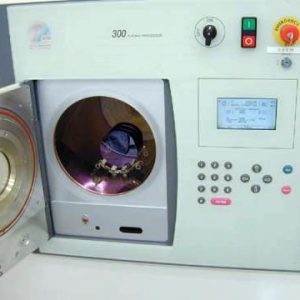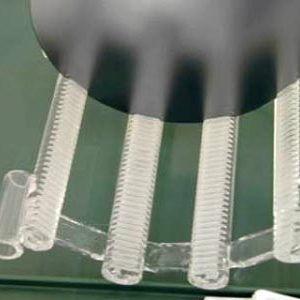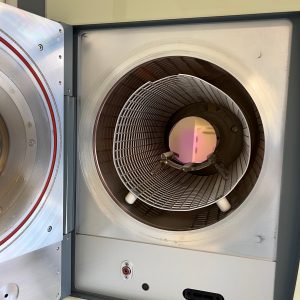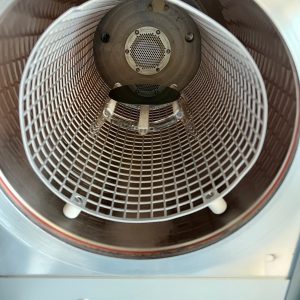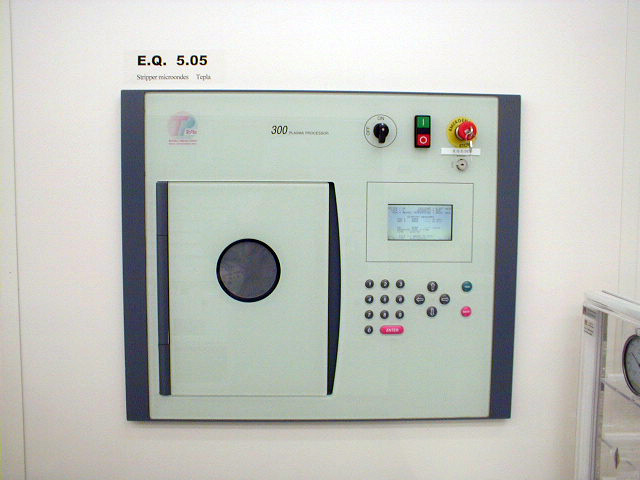
Contents
- Introduction
- Equipement description
- Standard processes
- How to use the system
- Allowed materials
- Forbidden processes
If you have any doubts about your layers, please ask staff in charge before proceeding with the tools.
This equipment is NOT micro-electronic compatible. For micro-electronic compatibility, please use Oxford PRS900 or Tepla GigaBatch (zone 1).
Processes that have not been tested are: isotropic etching of glass, ceramic, SiO2, Si3N4, Si.
I. Introduction ↑
The Tepla 300 uses high frequency plasma. Main applications are:
- Photo Resist (PR) stripping.
- Wafers surface cleaning before subsequent processes.
- Enhancement of hydrophilic behavior of plastics surfaces.
II. Equipement description ↑
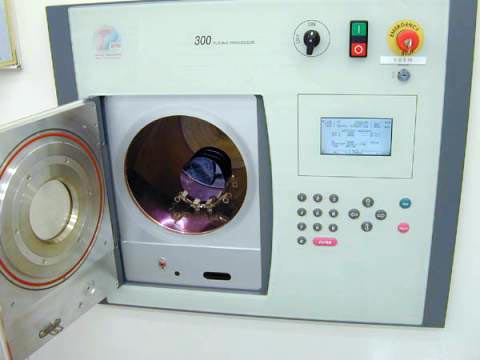
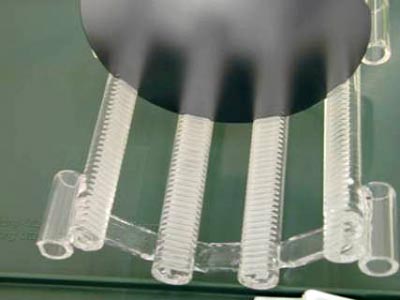
- Quartz primary vacuum chamber (dimension: Dint. 245 mm x Prof. 380 mm)
- Plasma frequency: 2.45 GHz
- Plasma power: 200 to 1000 W
- Gas : O2 and CF4 (max. flow 500 ml/min)
- Quartz holders for 25 wafers from 75 mm to 100 mm
III. Standard processes ↑
Resist strip
Positive resists etch rate = 350 nm/min depending on the number of wafers to be processed in the batch.
| Program | Gas 1 (O2, ml/min) | Gas 2 (CF4, ml/min) | Power (W) | Time (mm:ss) | EPD (0, 1, 2) | Remarks |
| 01 | 400 | 0 | 500 | 01:00 | 1 | 1 min over-etch after end point detection |
| 02 | 400 | 0 | 500 | 00:30 | 0 | |
| 03 | 400 | 0 | 500 | 01:00 | 0 | |
| 04 | 400 | 0 | 500 | 04:00 | 0 | |
| 05 | 400 | 0 | 500 | 07:00 | 0 | |
| 06 | 400 | 0 | 500 | 10:00 | 0 | |
| 08 | 400 | 0 | 500 | 20:00 | 0 | |
| 07 | 500 | 0 | 1000 | 30:00 | 0 | Strip for 25 wafers batch |
Si3N4 strip
Si3N4 etch rate= 230nm/min epending on the number of wafers to be processed in the batch.
Uniformity: 16%
Selectivity to SiO2: 3.5
Selectivity to resist: < 1 !
| Program | Gas 1 (O2, ml/min) | Gas 2 (CF4, ml/min) | Power (W) | Time (mm:ss) | EPD (0, 1, 2) | Remarks |
| 21 | 35 | 200 | 400 | 00:30 | 0 | |
| 22 | 35 | 200 | 400 | 00:50 | 0 | |
| 23 | 35 | 200 | 400 | 01:20 | 0 |
Surface activation
| Program | Gas 1 (O2, ml/min) | Gas 2 (CF4, ml/min) | Power (W) | Time (mm:ss) | EPD (0, 1, 2) | Remarks |
| 10 | 400 | 0 | 1000 | 01:00 | 0 | |
| 11 | 400 | 0 | 1000 | 00:30 | 0 | |
| 12 | 400 | 0 | 1000 | 00:15 | 0 | |
| 13 | 400 | 0 | 750 | 01:00 | 0 | |
| 14 | 400 | 0 | 750 | 00:30 | 0 | |
| 15 | 400 | 0 | 750 | 00:15 | 0 | |
| 16 | 400 | 0 | 600 | 01:00 | 0 | |
| 17 | 400 | 0 | 600 | 00:30 | 0 | |
| 18 | 400 | 0 | 600 | 00:15 | 0 | |
| 25 | 200 | 0 | 100 | 00:10 | 0 | |
| 26 | 400 | 0 | 500 | 00:45 | 0 | |
| 27 | 400 | 0 | 500 | 00:30 | 0 | |
| 28 | 400 | 0 | 500 | 00:15 | 0 | |
| 29 | 400 | 0 | 500 | 00:10 | 0 | |
| 30 | 400 | 0 | 500 | 00:05 | 0 | |
| 35 | 400 | 0 | 350 | 05:00 | 0 | |
| 36 | 400 | 0 | 350 | 00:45 | 0 | |
| 37 | 400 | 0 | 350 | 00:30 | 0 | |
| 38 | 400 | 0 | 350 | 00:15 | 0 | |
| 39 | 400 | 0 | 350 | 00:10 | 0 | |
| 40 | 400 | 0 | 350 | 00:05 | 0 | |
| 41 | 400 | 0 | 150 | 10:00 | 0 | |
| 42 | 400 | 0 | 200 | 10:00 | 0 | |
| 43 | 400 | 0 | 200 | 00:30 | 0 | |
| 44 | 400 | 0 | 200 | 00:15 | 0 | |
| 45 | 400 | 0 | 200 | 00:10 | 0 | |
| 46 | 400 | 0 | 200 | 00:05 | 0 |
Using the Faraday cage
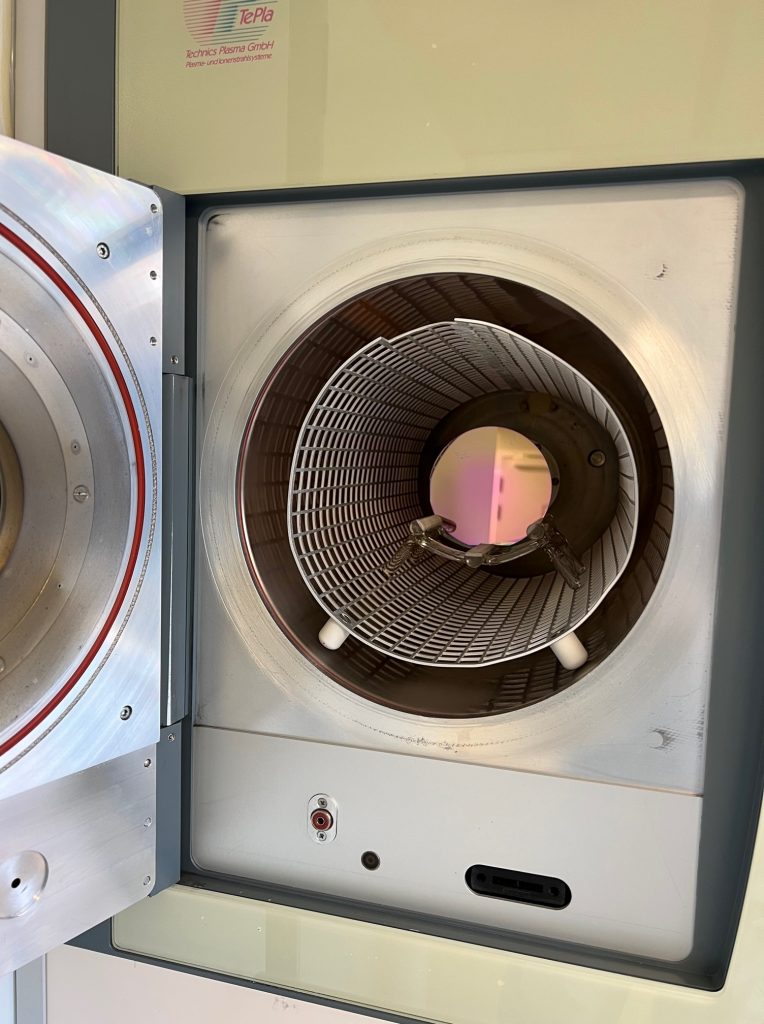
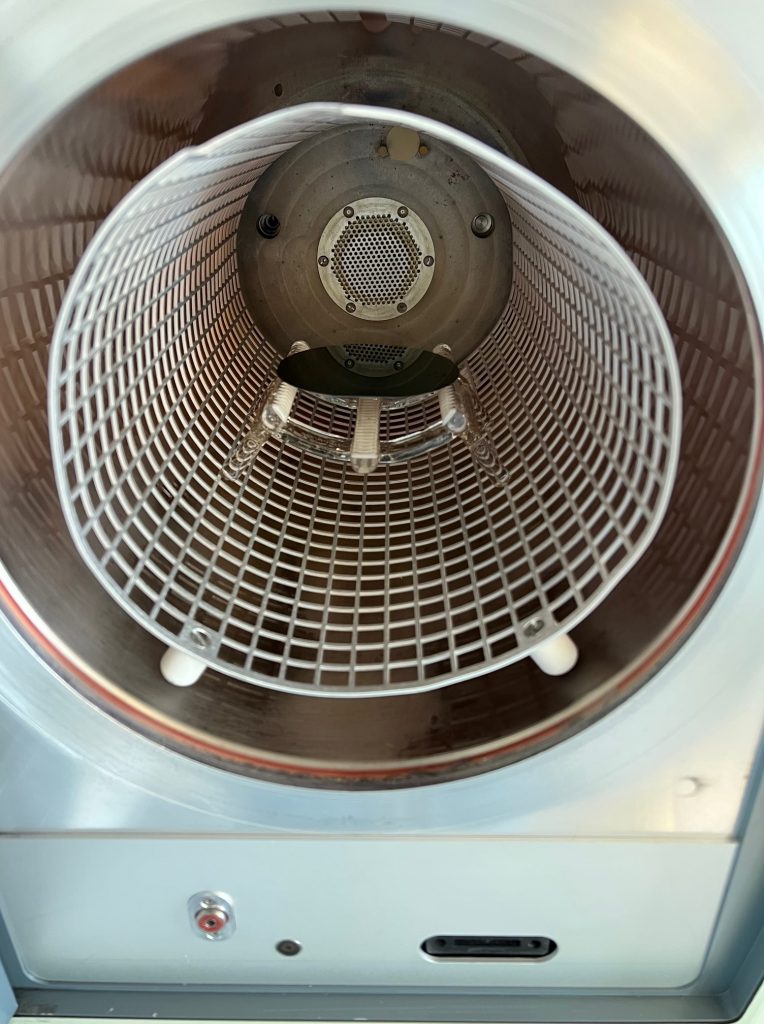
A Faraday cage is available to fit in the chamber prior to loading the samples.
The Faraday cage avoids direct coupling of microwave radiation from the source into the wafers, thus maintaining low wafer temperature.
The oxygen radicals are created outside the Faraday cage. Only they diffuse through the perforated sidewall of the cage to reach the samples.
These two effects (low temperature and distance to radicals creation) allow for more gentle process.
See this document of process references.
IV. How to use the system ↑
The substrates are processed following this procedure:
- Login on the Tepla plasma stripper on zone 11 computer.
- Activate the rectangular green “I” button on the machine
- The machine is on stand-by mode (“Idle” mode). Kill this mode by pressing the “abort” button
- Prepare the quartz carrier: CAUTION, it is very fragile! Use the fork to delicately manipulate the carrier.
Reminder: Materials that deteriorate easily upon exposure to oxygen (Ag, Cu, Cr, Fe, …) should not be processed in this machine! - Select the program: press “enter”, use the arrows to make your choice in the menu and press “enter” to validate
- programs 1 to 8 : resist
- programs 21 to 23: Si3N4
- programs 10 to 18 and 25 to 46: surface activation
- Start the process by pressing “run” (close the door to start the pumping). You can stop the process at anytime by pressing “abort”
- The chamber returns automatically at atmospheric pressure
- Take back the quartz carrier (CAUTION, it is hot: delicately use the fork) and your substrates
- Check the cleanliness of the chamber
- Put the equipment in stand-by mode: press “enter”, use the arrows to select “idle mode” and press “enter” (close the door to start the pumping)
- Perform Tepla logout on zone 11 computer
V. Allowed materials ↑
- Wafers: Si, glass, Pyrex, without metallic layers if possible.
- Plastics foils: Caution, special holder and limited power (material fusion)
VI. Forbidden processes ↑
Processes that use the following equipments:
- Zone 3
- All equipments of 3.
- Zone 4
- Deposition at temperature higher than room temperature in SPIDER
These processes must use the Oxford PRS900 (zone 2).
